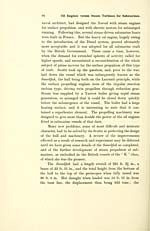Two centuries of shipbuilding by the Scotts at Greenock
(171) Page 85
Download files
Complete book:
Individual page:
Thumbnail gallery: Grid view | List view

British Submarines with Oil Engines. 85
engines. Two of these were of the well-known " E " class, the
overall length of which was 181 ft., the beam 22 ft. 8 in. over
the side tanks, and the displacement when submerged 839 tons.
One of these boats, E. 31, was fitted with five 18-in. torpedo tubes,
two in the bow, two in the broadside, and one in the stern.
Each tube was provided with one spare torpedo, the total
carried being therefore ten. The radius of action at the
cruising speed of 10 knots was 3225 nautical miles, with a
total oil fuel capacity of 42 tons. A surface speed of 15 knots
was obtained by twin screws, driven by 8-cylinder heavy oil
engines of the four-cycle, vertical single-acting type, each
developing 800 brake horse-power. The electro-motors for
use with the vessel submerged developed 420 brake horse-
power, giving a speed of 10 knots. The other " E " boat referred
to was E. 51, which was of special type, being designed and
fitted out for mine-laying. Another notable boat built by
Scotts was of the " G " class, which, it is important to observe,
had a double hull, arranged as in the " S " boats. This vessel,
G. 14, was 187 ft. long, 22 ft. 8 in. beam, with a submerged
displacement of 1026 tons, which was greater than in the " E "
class, owing to the adoption of the double hull. Her twin-
screw engines were constructed by Scotts, and were of the
two-cycle reversible Scott-Fiat type. The armament com-
prised two 18-in. bow torpedo tubes, two 18-in. broadside
tubes, and one 21 -in. stern tube ; and, in addition, two guns
were carried, one being of the disappearing type, with a calibre
of 3 in., and the other, a 2-pounder high-angle-fire gun, for
attacking aircraft.
Perhaps the most important development in connection
with submarine work by the Scotts was the design of the first
steam-driven submarine built for the British Navy. The
lack of reliable and safe oil engines in the 'eighties and early
'nineties had induced the French naval authorities of that
period to consider the question of reviving steam machinery
for submarine craft. In 1896 Laboeuf, the well-known French
engines. Two of these were of the well-known " E " class, the
overall length of which was 181 ft., the beam 22 ft. 8 in. over
the side tanks, and the displacement when submerged 839 tons.
One of these boats, E. 31, was fitted with five 18-in. torpedo tubes,
two in the bow, two in the broadside, and one in the stern.
Each tube was provided with one spare torpedo, the total
carried being therefore ten. The radius of action at the
cruising speed of 10 knots was 3225 nautical miles, with a
total oil fuel capacity of 42 tons. A surface speed of 15 knots
was obtained by twin screws, driven by 8-cylinder heavy oil
engines of the four-cycle, vertical single-acting type, each
developing 800 brake horse-power. The electro-motors for
use with the vessel submerged developed 420 brake horse-
power, giving a speed of 10 knots. The other " E " boat referred
to was E. 51, which was of special type, being designed and
fitted out for mine-laying. Another notable boat built by
Scotts was of the " G " class, which, it is important to observe,
had a double hull, arranged as in the " S " boats. This vessel,
G. 14, was 187 ft. long, 22 ft. 8 in. beam, with a submerged
displacement of 1026 tons, which was greater than in the " E "
class, owing to the adoption of the double hull. Her twin-
screw engines were constructed by Scotts, and were of the
two-cycle reversible Scott-Fiat type. The armament com-
prised two 18-in. bow torpedo tubes, two 18-in. broadside
tubes, and one 21 -in. stern tube ; and, in addition, two guns
were carried, one being of the disappearing type, with a calibre
of 3 in., and the other, a 2-pounder high-angle-fire gun, for
attacking aircraft.
Perhaps the most important development in connection
with submarine work by the Scotts was the design of the first
steam-driven submarine built for the British Navy. The
lack of reliable and safe oil engines in the 'eighties and early
'nineties had induced the French naval authorities of that
period to consider the question of reviving steam machinery
for submarine craft. In 1896 Laboeuf, the well-known French
Set display mode to:
![]() Universal Viewer |
Universal Viewer | ![]() Mirador |
Large image | Transcription
Mirador |
Large image | Transcription
Images and transcriptions on this page, including medium image downloads, may be used under the Creative Commons Attribution 4.0 International Licence unless otherwise stated. ![]()
| Histories of Scottish families > Two centuries of shipbuilding by the Scotts at Greenock > (171) Page 85 |
|---|
| Permanent URL | https://digital.nls.uk/95740715 |
|---|
| Description | A selection of almost 400 printed items relating to the history of Scottish families, mostly dating from the 19th and early 20th centuries. Includes memoirs, genealogies and clan histories, with a few produced by emigrant families. The earliest family history goes back to AD 916. |
|---|

